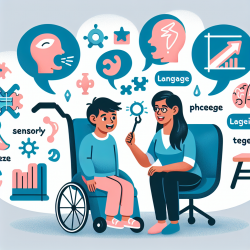As a Special Education Director with a passion for advancing educational practices, I often encounter the challenge of integrating complex research findings into actionable strategies for our dedicated practitioners. One area of ongoing exploration and potential growth is the application of Piagetian principles to therapy for children with developmental disorders of language. Drawing on insights from the seminal work outlined in "Piagetian Activities-A Diagnostic and Developmental Approach" by Richard Copeland, this post aims to guide practitioners on how to utilize these principles to refine their therapy techniques and encourage further research in this domain.
Piaget's cognitive development theory offers a robust framework for understanding how children construct knowledge, which is particularly relevant in the context of language disorders. Copeland's book represents a practical translation of these theories into 62 activities that target logical thinking development. These activities span various cognitive domains such as logical classification, number, space orientation, and memory, each sequenced according to developmental stages and cognitive levels expected at different ages.
Implementing Piagetian Principles in Therapy
- Assessment and Individualization: Begin by assessing the child's current cognitive and language abilities. Copeland's activities can help identify specific areas of difficulty and cognitive strengths, allowing for targeted intervention strategies that align with the child's developmental stage.
- Activity Selection: Choose activities that complement the child's linguistic goals. For example, if working on prepositions, select space orientation activities to reinforce understanding through cognitive and linguistic channels simultaneously.
- Verbal Mediation and Experience: Copeland emphasizes moving beyond "show and tell" methods. Instead, he suggests using stimulating questions and providing physical and social experiences that promote abstract thinking. This approach can be particularly beneficial for children with language disorders, as it encourages active engagement and problem-solving.
- Monitoring Progress: Regularly reassess the child's abilities to adjust the difficulty level of activities. This dynamic approach ensures that therapy remains challenging yet achievable, fostering a sense of accomplishment and motivating further learning.
Encouraging Further Research
While Copeland's book offers a valuable resource for practitioners, it also highlights the need for further research. The anecdotal nature of some suggestions and the lack of empirical data supporting specific interventions underline the importance of ongoing investigation in this area. Practitioners are encouraged to document their observations, outcomes, and modifications to Piagetian activities, contributing to a growing body of knowledge that can inform future therapeutic approaches.
In conclusion, integrating Piagetian principles into therapy for children with developmental disorders of language offers a promising avenue for enhancing cognitive and linguistic development. By carefully selecting and adapting activities based on individual assessments, practitioners can provide more effective and engaging interventions. Moreover, by engaging in and promoting further research, we can continue to refine and expand our understanding of how best to support the unique needs of each child we serve.
To read the original research paper, please follow this Developmental Disorders of Language.










